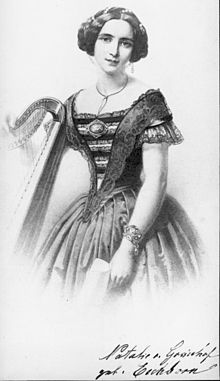Raphael Schall
Raphael Joseph Albert Schall (born December 27, 1814 in Breslau ; † August 18, 1859 there ) was a Nazarene history , church and portrait painter from the Düsseldorf School .
Life

Schall received his first instruction in painting from his father Joseph Schall (1785–1869), who was a lithographer, watercolor and miniature painter and drawing teacher at Matthias Gymnasium in Breslau . Already at the age of 12 he took part in the Wroclaw Art Exhibition in 1827. Together with his friends Philipp Hoyoll and Amand Pelz , Schall then studied at the Royal Art School in Breslau under the portrait painter Johann H. Chr. König (1777–1867). After a short stay at the Royal Academy of Arts in Berlin (1833), where his friend Adolph Menzel studied, the three painter friends switched to the Düsseldorf Art Academy. There they attended Karl Ferdinand Sohn's class together . From 1837 to 1841, Schall was a student of Wilhelm Schadow , the director of the academy, under whose influence he turned to the religious painting of the Nazarene . In 1840 Schall painted the altarpiece Christ blessing the chalice , in 1841 the altarpiece Queen of Heaven . The art association for the Rhineland and Westphalia donated the first picture of the village church in Bockhorst (Westphalia) and the second picture of a church in Rellinghausen . During this time, Schall also took part in exhibitions (1841: Frankfurter Kunstverein and Leipzig Art Exhibition; 1842 and 1844: Berlin Academic Art Exhibition). In 1842 he received an order from the Prussian Queen Elisabeth to decorate the chapel of Stolzenfels Castle . The painting earned him a grant from the Prussian state, which took him to Italy in 1844/1845 for further training as a history and church painter. There he painted the historical picture of Dear Saint Elisabeth of Thuringia, Farewell to her husband Landgrave Ludwig the Saint in 1227 , a major work that has been lost. After returning from Italy, he received an order for fresco decorations in Stolzenfels Castle. Then he returned to Breslau, where he married Elisabeth Hamacher in 1846, the sister of the Düsseldorf painter Theodor Hamacher , with whom he restored the wall frescoes of the Resurrection Chapel in Breslau Cathedral in 1851 . Both painters were particularly encouraged by the Breslau canon and later bishop Heinrich Förster ; especially her pictures found their way into his collection. In 1935 the Silesian Museum of Fine Arts devoted a special exhibition to Schall.
Works (selection)

As a church painter for the Diocese of Breslau , Schall created a large number of altarpieces and stations of the cross, and occasionally wall paintings. His work is largely lost. Bundles of drawings can be found in the Diocesan Museum in Wroclaw, in the National Museums in Warsaw and Wroclaw , in the latter also a copy of the diary of his Italian trip.
- Double portrait of the Breslau childhood friends Robert Eitner and Albert Korneck , 1833
- Together with Philipp Hoyoll and Amand Pelz: Three Silesian painters. Friendship and studio picture of Philipp Hoyoll (left in front of the easel, painted by Schall), Amand Pelz (in the middle with palette, painted by Hoyoll) and Raphael Schall (right with pencil, painted by Pelz), 1835, National Gallery Berlin
- Madonna with the Sleeping Child , 1837.
- Christmas Eve , 1837
- Christ blessing the chalice , altarpiece 1840, since 1847 in the village church Bockhorst , today on the wall of the main nave
- Queen of Heaven , altarpiece 1841.
- Elisabeth Hamacher , Portrait of the Bride, 1843.
- Dear Saint Elisabeth of Thuringia, farewell to her husband Landgrave Ludwig the Holy in 1227 , 1844/1845
- Mary's Annunciation
- Together with Theodor Hamacher: Wall frescoes in the Resurrection Chapel in Breslau Cathedral , 1851
- Natalie Eschborn , 1850s
literature
- Ernst Schreyer: Johann H. Chr. König and the Silesian Citizen Portrait. In: Silesian painting of the Biedermeier period. (= Volume 2 of Architectural and Art Monuments of the German East: Silesia ). Weidlich, Frankfurt am Main 1965, p. 60 ff. (Five images)
Web links
- Schall, Raphael Joseph Albert , biography in the portal kulturportal-ost-west.eu
Individual evidence
- ^ Organ for Christian Art . April 15, 1853 edition, p. 63 ( Google Books )
- ↑ Joana Lubos-Kozieł: The painting collection of the Bishop Heinrich Förster . Website on 12 April 2010 at the Portal schlesischesammlungen.eu , accessed on April 1, 2015.
- ↑ Bettina Baumgärtel: Three Silesian Painters, 1835. In: Bettina Baumgärtel (ed.): The Düsseldorf School of Painting and its International Radiance 1819–1918 . Michael Imhof Verlag, Petersberg 2011, ISBN 978-3-86568-702-9 , Volume 2, p. 53 (Catalog No. 29)
- ↑ Data sheet Three Silesian Painters , accessed on the portal bildindex.de on April 1, 2015.
- ^ Georg Kaspar Nagler : New general artist lexicon . Fifteenth volume, Verlag EA Fleischmann, Munich 1845, p. 134 ( Google Books )
- ↑ Tour through the Bockhorster village church , website in the portal kirche-bockhorst.de , accessed on April 1, 2015.
| personal data | |
|---|---|
| SURNAME | Schall, Raphael |
| ALTERNATIVE NAMES | Schall, Raphael Joseph Albert (full name) |
| BRIEF DESCRIPTION | Nazarene history, church and portrait painter |
| DATE OF BIRTH | December 27, 1814 |
| PLACE OF BIRTH | Wroclaw |
| DATE OF DEATH | August 18, 1859 |
| Place of death | Wroclaw |